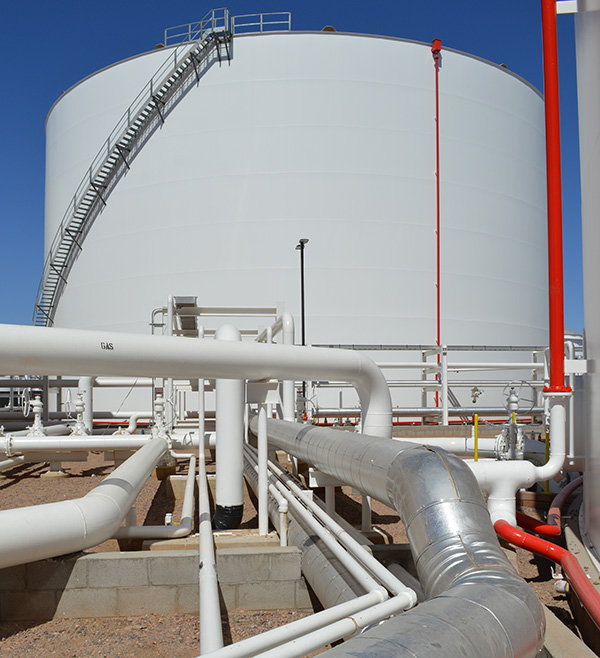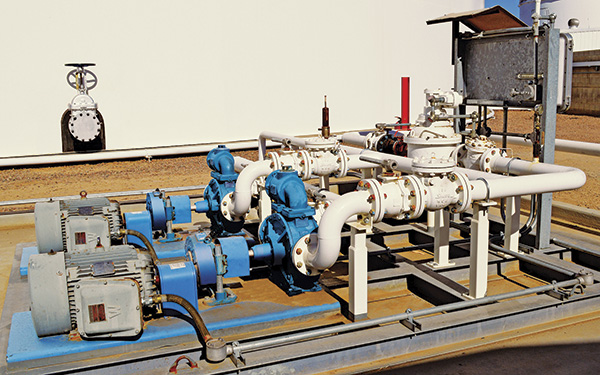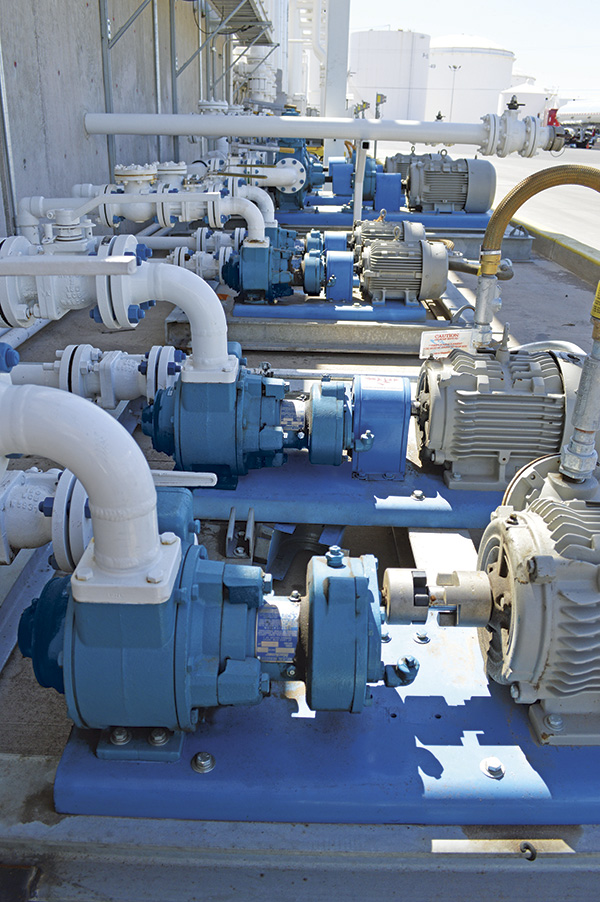Millions of gallons of refined petroleum products pass through storage facilities on a daily basis. Terminal operators must employ a battalion of transfer pumps that operate reliably and cost-effectively at predetermined flow rates. While operators have several choices, including centrifugal, gear and lobe pumps, storage terminal networks present unique challenges that must be considered when selecting equipment.
Transfer pumps play a key role in the terminal’s supply chain, but they are also the terminal’s biggest energy consumers. According to a report from the United Nations Industrial Development Organization, pumps can account for up to 20 percent of total electricity use in the industrial sector, and a pumping system’s average efficiency is about 40 percent or less. When efficiency is low, pumps consume more energy, produce more emissions and fail more often. At storage terminals, operators must maximize throughputs while using energy efficiently.
 Image 1. Storage facilities can experience large-scale benefits from efficiency improvements. (Images courtesy of Blackmer)
Image 1. Storage facilities can experience large-scale benefits from efficiency improvements. (Images courtesy of Blackmer)Too many terminal operators still reflexively depend on centrifugal pumps, which are not the most energy-efficient choice for their application. Centrifugal pumps rarely operate at their best efficiency point (BEP)—the point when product flow rate and discharge pressure are equal around the pump’s impeller and volute. As a centrifugal pump moves away from its BEP, the impeller experiences uneven pressure. The resulting radial thrust will cause the pump shaft to deflect. When the shaft deflects, excess load on the bearings can damage the mechanical seal and lead to uneven wearing of the gland packing or shaft sleeve. Once a centrifugal pump operates too far away from its BEP, cavitation occurs, which can quickly destroy the pump casing, back plate and impeller.
Centrifugal pumps pose other challenges in storage terminal operations. Performance often suffers when pumping fluids with a viscosity higher than 400 centistokes. Flow rate control can become a serious maintenance issue. Low-flow centrifugal pumps consume more energy and require more pressure, while higher flow rates can lead to friction loss. Terminal operators often select oversized pumps for their application, increasing energy consumption as well as operating and maintenance costs.
Sliding Vane Pumps
Positive displacement sliding vane pumps are a more efficient, cost-effective replacement for centrifugal pumps in storage terminals. These pumps allow operators to meet energy-saving initiatives while maintaining throughput rates. By integrating this technology with a systems approach to the pumping system, the storage terminal’s overall efficiency and profitability will improve.
 Image 2. Sliding vane pumps eliminate slip and minimize pulsation.
Image 2. Sliding vane pumps eliminate slip and minimize pulsation.In sliding vane pumps, several vanes slide in and out of slots in the pump rotor. The vanes form pumping chambers as the vanes move outward and bear against the inner bore of the pump casing. Fluid flows into these chambers as the rotor turns, traveling around the pump casing until it reaches the discharge.
Positive displacement sliding vane pumps can handle a wide range of viscosities, from very thin liquids to liquids up to 50,000 centistokes. Flow rates are directly proportional to the pump’s speed and can reach as high as 7,850 liters per minute. The pumps can also effectively generate high pressures when needed for low-flow applications.
 Image 3. In sliding vane pumps, the vanes form pumping chambers that transfer fluid as the rotor turns.
Image 3. In sliding vane pumps, the vanes form pumping chambers that transfer fluid as the rotor turns.The self-adjusting vanes eliminate slip, which robs the system of energy, and ensure high volumetric efficiency. The rotary design minimizes pulsation, while suction-lift and line-stripping capabilities help optimize product recovery. Hydrodynamic journal bearings reduce friction, heat and energy loss. The pumps can also run dry and self-prime.
An average storage terminal facility may spend $1.4 million annually on energy to run their pumping systems. Sliding vane pumping systems can help produce energy savings averaging about $350,000 per year.
Real Savings
Storage terminal operators must make every effort to optimize energy efficiency at their facilities. Central to energy-saving initiatives is selecting the right pumping system for handling refined petroleum products. Positive displacement sliding vane pumps meet the needs of storage terminal networks while reducing the energy demands typical with centrifugal pumps. With the help of systems designed around sliding vane technology, terminal companies can control energy expenses without compromising performance.


